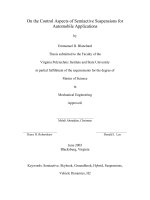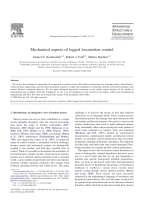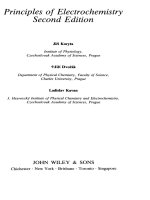Modern aspects of electrochemistry no 31 bockris
Bạn đang xem bản rút gọn của tài liệu. Xem và tải ngay bản đầy đủ của tài liệu tại đây (6.18 MB, 365 trang )
MODERN ASPECTS OF
ELECTROCHEMISTRY
No. 31
LIST OF CONTRIBUTORS
JENS E. T. ANDERSEN
Department of Chemistry
The Technical University of Denmark
DK-2800 Lyngby, Denmark
MARIA JURKIEWICZ-HERBICH
Department of Chemistry
University of Warsaw
02-089 Warsaw, Poland
AKIKO ARAMATA
Catalysis Research Center
Hokkaido University
Sapporo 060, Japan
SHAHED U. M. KHAN
Department of Chemistry and
Biochemistry
Duquesne University
GREGERS BECH-NIELSEN
Department of Chemistry
The Technical University of Denmark
DK-2800 Lyngby, Denmark
JOHN C. REEVE
Department of Chemistry
The Technical University of Denmark
DK-2800 Lyngby, Denmark
ILAN BENJAMIN
Department of Chemistry
University of California
Santa Cruz, California 95064
JERZY SOBKOWSKI
Department of Chemistry
University of Warsaw
02-089 Warsaw, Poland
Pittsburgh, Pennsylvania 15282-1503
ANNE DORTHE BISGÅRD
Department of Manufacturing
Engineering
The Technical University of Denmark
DK-2800 Lyngby, Denmark
A Continuation Order Plan is available for this series. A continuation order will bring
delivery of each new volume immediately upon publication. Volumes are billed only
upon actual shipment. For further information please contact the publisher.
MODERN ASPECTS OF
ELECTROCHEMISTRY
No. 31
Edited by
J. O’M. BOCKRIS
Texas A&M University
College Station, Texas
RALPH E. WHITE
University of South Carolina
Columbia, South Carolina
and
B. E. CONWAY
University of Ottawa
Ottawa, Ontario, Canada
KLUWER ACADEMIC PUBLISHERS
NEW YORK, BOSTON, DORDRECHT, LONDON, MOSCOW
eBook ISBN:
Print ISBN:
0-306-46910-3
0-306-45650-8
©2002 Kluwer Academic Publishers
New York, Boston, Dordrecht, London, Moscow
Print ©1999 Kluwer Academic / Plenum Publishers
New York
All rights reserved
No part of this eBook may be reproduced or transmitted in any form or by any means, electronic,
mechanical, recording, or otherwise, without written consent from the Publisher
Created in the United States of America
Visit Kluwer Online at:
and Kluwer's eBookstore at:
Preface
Prof. Jerzy Sobkowski starts off this 31st volume of Modern Aspects of
Electrochemistry with a far-ranging discussion of experimental results
from the past 10 years of interfacial studies. It forms a good background
for the two succeeding chapters.
The second chapter is by S. U. M. Khan on quantum mechanical
treatment of electrode processes. Dr. Khan’s experience in this area is a
good basis for this chapter, the contents of which will surprise some, but
which as been well refereed.
Molecular dynamic simulation is now a much-used technique in
physical electrochemistry and in the third chapter Ilan Benjamin has
written an account that brings together information from many recent
publications, sometimes confirming earlier modeling approaches and
sometimes breaking new territory.
In Chapter 4, Akiko Aramata’s experience in researching single
crystals is put to good advantage in her authoritative article on underpotential deposition.
Finally, in Chapter 5, the applied side of electrochemistry is served
by Bech-Neilsen et al. in the review of recent techniques for automated
measurement of corrosion.
J. O’M. Bockris, Texas A&M University
B. E. Conway, University of Ottawa
R. E. White, University of South Carolina
This Page Intentionally Left Blank
Contents
Chapter 1
METAL/SOLUTION INTERFACE: AN EXPERIMENTAL
APPROACH
Jerzy Sobkowski and Maria Jurkiewicz-Herbich
I. Introduction. . . . . . . . . . . . . . . . . . . . . . . . . . . . . . . . . . . . . . . . . . . . . . 1
II. Molecular Approach to the Metal/Solution Interface. . . . . . . . . . . . . 3
1. Double-Layer Structure: General Considerations . . . . . . . . . . 3
2. Solid Metal/Electrolyte Interface. . . . . . . . . . . . . . . . . . . . . . . . . . 8
3. Methods Used to Study Properties of the Metal/Solution
Interface: Role of the Solvent and the Metal............. 15
III. The Thermodynamic Approach to the Metal/Solution Interface 35
1. The Standard Gibbs Energy of Adsorption,
. . . . . . . . . . 35
2. Effect of Supporting Electrolyte on Electrosorption......... 54
References. . . . . . . . . . . . . . . . . . . . . . . . . . . . . . . . . . . . . . . . . . . . . . . 63
Chapter 2
QUANTUM MECHANICAL TREATMENTS IN ELECTRODE
KINETICS
Shahed U.M. Khan
I. Introduction. . . . . . . . . . . . . . . . . . . . . . . . . . . . . . . . . . . . . . . . . 71
II. Continuum Theory of Electron Transfer Reactions . . . . . . . . . . 72
1. Born Equation and the Free Energy of Activation,
(continuum). . . . . . . . . . . . . . . . . . . . . . . . . . . . . . . . . . 74
vii
viii
Contents
2. Reorganization Energy (Continuum) and the Free
Energy of Activation
. . . . . . . . . . . . . . . . . . . . . . . . . . . . 76
(Continuum) and the Inverted Region . . . . . . . . . . . . . . . . 79
III.
1. General . . . . . . . . . . . . . . . . . . . . . . . . . . . . . . . . . . . . . . . . . 79
2. ET Reactions at Electrodes and the Inverted Region . . . . . . 83
IV. Molecular Models of Electron Transfer Reactions at
Electrodes. . . . . . . . . . . . . . . . . . . . . . . . . . . . . . . . . . . . . . . . . . 85
1. Free Energy of Activation,
and the Molecular Models 86
V. Molecular Models of Bond-Breaking Ion and Electron
Transfer Reactions. . . . . . . . . . . . . . . . . . . . . . . . . . . . . . . . . . . . . . . 94
1. Classical and Semiclassical Treatments . . . . . . . . . . . . . . . . 95
2. Quantal Treatments. . . . . . . . . . . . . . . . . . . . . . . . . . . . . . . . 99
VI. Electronic Transmission Coefficient κ . . . . . . . . . . . . . . . . . 102
VII. Proton Transfer Reactions . . . . . . . . . . . . . . . . . . . . . . . . . . . . 104
VIII. Solvent Dynamic Effects on ET Reactions at Electrodes . . . . 107
References . . . . . . . . . . . . . . . . . . . . . . . . . . . . . . . . . . . . . . . . . . . . . 110
Chapter 3
MOLECULAR DYNAMIC SIMULATIONS IN INTERFACIAL
ELECTROCHEMISTRY
Ilan Benjamin
I. Introduction . . . . . . . . . . . . . . . . . . . . . . . . . . . . . . . . . . . . . . . 115
II. The Water/Metal Interface. . . . . . . . . . . . . . . . . . . . . . . . . . . . 116
Preliminary Notes . . . . . . . . . . . . . . . . . . . . . . . . . . . . . . . .
Potential Energy Functions . . . . . . . . . . . . . . . . . . . . . . . . .
Structure of Water at Metal Surfaces . . . . . . . . . . . . . . . . .
Dynamics. . . . . . . . . . . . . . . . . . . . . . . . . . . . . . . . . . . . . . . .
Effect of External Electric Field. . . . . . . . . . . . . . . . . . . . .
III. Ionic Adsorption and Solvation at the Water/Metal Interface
1. Overview. . . . . . . . . . . . . . . . . . . . . . . . . . . . . . . . . . . . . . .
2. Potential Energy Functions. . . . . . . . . . . . . . . . . . . . . . . . .
3. Single Ion Adsorption at the Water/Metal Interface.........
4. Simulations of Electrolyte Solutions at the Water/Metal
Interface . . . . . . . . . . . . . . . . . . . . . . . . . . . . . . . . . . . . . . .
1.
2.
3.
4.
5.
116
117
127
135
138
143
143
145
146
153
Contents
ix
IV. Interfacial Electron Transfer Reactions . . . . . . . . . . . . . . . . . .
1. Preliminaries . . . . . . . . . . . . . . . . . . . . . . . . . . . . . . . . . . . .
2. Two-State Models . . . . . . . . . . . . . . . . . . . . . . . . . . . . . . . .
3. Multistate Models . . . . . . . . . . . . . . . . . . . . . . . . . . . . . . . .
V. Processes at the Liquid/Liquid Interface . . . . . . . . . . . . . . . . .
VI. Conclusions and Outlook . . . . . . . . . . . . . . . . . . . . . . . . . . . . .
References. . . . . . . . . . . . . . . . . . . . . . . . . . . . . . . . . . . . . . . . . . . . . .
154
154
156
168
170
172
173
Chapter 4
UNDERPOTENTIAL DEPOSITION ON SINGLE-CRYSTAL
METALS
Akiko Aramata
I. Introduction. . . . . . . . . . . . . . . . . . . . . . . . . . . . . . . . . . . . . . . . 181
1. Scope of this Chapter.................................. 181
2. Preparation and Qualification of Single Crystals........... 183
3. Well-Defined Surface Structure and Reconstruction of
Single-Crystal Surfaces . . . . . . . . . . . . . . . . . . . . . . . . . . . . 191
4. Anion Adsorption Behavior. . . . . . . . . . . . . . . . . . . . . . . . . 196
II. Underpotential Deposition on Single-Crystal Electrodes . . . . 200
1. Underpotential Deposition on Au Single Crystals........... 201
2. Underpotential Deposition on Single-Crystal Pt
Group Metals...................................... 212
3. Underpotential Deposition on Ag Single Crystals........... 219
4. Underpotential Deposition and Anion Adsorption . . . . . . . 224
III. Mechanism of Underpotential Deposition . . . . . . . . . . . . . . . . 231
1. Kinetics and Dynamics . . . . . . . . . . . . . . . . . . . . . . . . . . . . 231
IV. Electrocatalysis on Electrodes Modified by
Underpotential Deposition. . . . . . . . . . . . . . . . . . . . . . . . . . . . 240
V. Miscellaneous . . . . . . . . . . . . . . . . . . . . . . . . . . . . . . . . . . . . . . 241
1. Bimetallic Underpotential Deposition. . . . . . . . . . . . . . . . . . . . . 241
2. Effect of Underpotential Deposition on Overpotential
Deposition . . . . . . . . . . . . . . . . . . . . . . . . . . . . . . . . . . . . . . 241
3. Effect of Organic Additives on Underpotential Deposition 242
4. Underpotential Deposition in Nonaqueous Solvents. . . . . . 243
VI. Conclusion . . . . . . . . . . . . . . . . . . . . . . . . . . . . . . . . . . . . . . . . 243
References. . . . . . . . . . . . . . . . . . . . . . . . . . . . . . . . . . . . . . . . . . . . . . 245
x
Contents
Chapter 5
AUTOMATED METHODS OF CORROSION MEASUREMENT
Gregers Bech-Nielsen, Jens E.T. Andersen, John C. Reeve,
Anne D. Bisgård and Lars Vendelbo Nielsen
I. Introduction . . . . . . . . . . . . . . . . . . . . . . . . . . . . . . . . . . . . . . . . . . 251
II. Corrosion Measurements by Titration. . . . . . . . . . . . . . . . . . . . . . . 252
1. General . . . . . . . . . . . . . . . . . . . . . . . . . . . . . . . . . . . . . . . . 252
2. Restrictions and Limitations of CMT Measurements..... 253
3. CMT Measurements with a Polarized Electrode . . . . . . . . 257
4. Instrumentation and Recording of CMT Measurements .. 259
5. Aim and Results of CMT Measurements . . . . . . . . . . . . . . 263
6. Concluding Remarks. . . . . . . . . . . . . . . . . . . . . . . . . . . . . . . . . 269
III. Imaging Corrosion by Scanning Probe Microscopy . . . . . . . . 269
1. General . . . . . . . . . . . . . . . . . . . . . . . . . . . . . . . . . . . . . . . . 269
2. Use of STM and AFM in Corrosion Studies . . . . . . . . . . . 270
3. Concluding Remarks. . . . . . . . . . . . . . . . . . . . . . . . . . . . . . 281
IV. Critical Pitting Temperature. . . . . . . . . . . . . . . . . . . . . . . . . . . . . . . . . . 282
1. General . . . . . . . . . . . . . . . . . . . . . . . . . . . . . . . . . . . . . . . . . . . 282
2. Experimental Equipment for CPT Testing . . . . . . . . . . . . . 286
3. Methods for Pitting Characterization . . . . . . . . . . . . . . . . . 290
4. Summary. . . . . . . . . . . . . . . . . . . . . . . . . . . . . . . . . . . . . . . . . . 297
5. Concluding Remarks. . . . . . . . . . . . . . . . . . . . . . . . . . . . . . . . . . 299
V. Applications of the Electrochemical Hydrogen
Permeation Cell. . . . . . . . . . . . . . . . . . . . . . . . . . . . . . . . . . . . . 299
1. General . . . . . . . . . . . . . . . . . . . . . . . . . . . . . . . . . . . . . . . . . . . 299
2. The Principle. . . . . . . . . . . . . . . . . . . . . . . . . . . . . . . . . . . . 299
3. Diffusion of Hydrogen into Metal . . . . . . . . . . . . . . . . . . . 301
4. Studies on the Hydrogen Evolution Reaction. . . . . . . . . . . . . . 302
5. Hydrogen-Related Stress Corrosion Cracking . . . . . . . . . . 306
6. Cell Types . . . . . . . . . . . . . . . . . . . . . . . . . . . . . . . . . . . . . . . . . . 309
7. Summary. . . . . . . . . . . . . . . . . . . . . . . . . . . . . . . . . . . . . . . 311
References
. . . . . . . . . . . . . . . . . . . . . . . . . . . . . . . . . . . . . . . . . . . . . 312
Contents
xi
Cumulative Author Index . . . . . . . . . . . . . . . . . . . . . . . . . . . . . . . . . . 317
Cumulative Title Index .................................... 331
Subject Index............................................ 341
This Page Intentionally Left Blank
MODERN ASPECTS OF
ELECTROCHEMISTRY
No. 31
This Page Intentionally Left Blank
1
Metal/Solution Interface: An Experimental
Approach
Jerzy Sobkowski and Maria Jurkiewicz-Herbich
Department of Chemistry, Warsaw University, Warsaw, Poland
I. INTRODUCTION
The electrical double layer has been dealt with in countless papers and in
a number of reviews, including those published in previous volumes of
the Modern Aspects of Electrochemistry series.1–9 The experimental
double layer data have been reported and commented on in several
important works in which various theories of the structure of the double
layer have been postulated. Nevertheless, many double layer-related problems have not been solved yet, mainly because certain important parameters describing the interface cannot be measured. This applies to the
electric permittivity, dipole moments, surface density, and other physical
quantities that are influenced by the electric field at the interface. It is also
often difficult to separate the electrostatic and specific interactions of the
solvent and the adsorbate with the electrode. To acquire necessary knowledge about the metal/solution interface, different metals, solvents, and
adsorbates have been studied.
In the earlier concepts of the interface structure, the metal was treated
as a reservoir of electrons, uniformly distributed in the bulk of the phase.
Spatial distribution of charges was considered mainly on the solution side.
No such considerations were made for the solid electrodes, except for the
Modern Aspects of Electrochemistry, Number 31, edited by John O’M. Bockris et al.
Plenum Press, New York, 1997
1
2
Jerzy Sobkowski and Maria Jurkiewicz-Herbich
case of semiconductors. The charge distribution in the metal, near the
interface, was taken into account when the jellium model of the metal was
proposed. This model was used to formulate a novel view of the doublelayer structure (e.g., Refs. 9 and 10).
Significant progress in understanding the structure of the metal/solution interface was achieved by studying electrochemical processes on
well-defined planes of single crystals.6 Early studies on single-crystal
electrodes were not satisfactorily reproducible because of difficulties in
growing the crystals, inaccurate cutting, and insufficient control of the
desired plane orientation. Later, the techniques of crystal preparation were
much improved and the number of papers dealing with adsorption and
electrochemical reactions on single-crystal electrodes increased substantially.
It appears that restructuring of the metal, reorientation of solvent
molecules, adsorption of the electrolyte species and coadsorption of
organics, and preoxidation and oxidation of the surface can be better
studied on monocrystals than on more complex polycrystalline electrodes.11 Moreover, an uncertainty inherent in determining surface roughness often makes quantitative comparisons of the polycrystalline data
difficult. This is because the quantities under scrutiny (e.g., current density
and differential capacity) usually have to be referred to the real surface
area of the electrode. The problem of roughness also exists in the case of
monocrystalline planes. However, careful polishing of the surface usually
limits the problem and results in the real surface of the electrode approaching the geometrical area. Still, the lack of an unambiguous method for
measuring roughness often seriously limits determination of surface concentration.
Even refined electrochemical methods cannot alone provide full
information about the molecular structure of the metal/ solution interface.
Hence, many nonelectrochemical techniques have been developed in the
past few decades to study the double layer. They include spectroscopic,
microscopic, radiochemical, microgravimetric, and other methods. A
combination of electrochemical (chronovoltammetry, chronocoulometry,
impedance spectroscopy, etc.) and nonelectrochemical methods is often
used in studying mechanisms of the electrode process.
Two main approaches to the investigation of the metal/solution interface can be distinguished: molecular and thermodynamic. In the first
Metal/Solution Interface: An Experimental Approach
3
approach, the interfacial state of the system is studied by various direct
methods, usually quite recent. In the thermodynamic approach, the energetics of metal–solvent and metal–adsorbate interactions is investigated
on the basis of parameters determined at the equilibrium.
The aim of this review is to present achievements and difficulties of
electrochemical research focused on the structure of the metal/solution
interface. The literature cited is generally limited to recent reviews and
original papers, with relatively little attention paid to the historical background. A more complete list of references on the subject was given by
Bockris and Khan in their book.12
II. MOLECULAR APPROACH TO THE METAL/SOLUTION
INTERFACE
1. Double-Layer Structure: General Considerations
For a long time, the electric double layer was compared to a capacitor with
two plates, one of which was the charged metal and the other, the ions in
the solution. In the absence of specific adsorption, the two plates were
viewed as separated only by a layer of solvent. This model was later
modified by Stern, who took into account the existence of the diffuse layer.
He combined both concepts, postulating that the double layer consists of
a rigid part called the inner—or Helmholtz—layer, and a diffuse layer of
ions extending from the outer Helmholtz plane into the bulk of the
solution. Accordingly, the potential drop between the metal and the bulk
consists of two parts:
where
and
are potentials of the metal surface, solution in the
bulk, and outer Helmholtz plane, respectively;
and
are the potential
drops, correspondingly in the inner and diffuse parts of the double layer.
Assuming that the double layer is composed of two capacitors, the
inner and the diffuse one, connected in series, which have the capacitanties
and
respectively, the measured total capacitance C can be expressed13:
4
Jerzy Sobkowski and Maria Jurkiewicz-Herbich
where is the electric permittivity of solvent at the surface,
is the
electric permittivity of a vacuum
a is the outer
Helmholtz layer thickness, r is the inner layer thickness,
is the
permittivity of the solvent between the inner and outer Helmholtz planes,
is the permittivity ofthe solvent in the bulk, and 1/κ is the Debye length.
According to this model, and in the absence of specific adsorption,
the adsorbed solvent molecules are located in the inner Helmholtz plane,
the thickness of which is determined by the radius of the molecule. At the
same time, solvated ions define the location of the outer Helmholtz plane.
Other ions, charged oppositely to the surface charge, are smeared out in
the diffuse layer.
However, in Eq. (2) as many as five parameters
and
1/κ) are adjustable and their values are not precisely known. For example,
the Debye length is calculated assuming that the electric permittivity near
the ions has the same value as in the bulk. However, the permittivity of
water decreases when it is brought closer to the ions or charged surface
because the structure of water is disturbed by the electric field. It was
estimated14 that is restored to 90% of the bulk value when the distance
from the electrode becomes ca. 6 Å. A similar conclusion is valid for
ion–water systems. In a 0.1M solution of a 1:1 electrolyte
the permittivity of water is regarded as undisturbed, but for higher ion
concentrations (e.g., a 1M solution of a 1:1 electrolyte,
the
value of is much lower than in the bulk. This may be a source of error
in calculating the diffuse layer capacitance when the concentration and
the charge of ions increase. It should be stressed that the concentration of
ions in the diffuse layer is greater than in the bulk though it is often not
taken into account in calculating the diffuse layer capacitance
The presence of the diffuse layer determines the shape of the
capacitance-potential curves. For a majority of systems, models describing the double-layer structure are oversimplified because of taking into
account only the charge of ions and neglecting their specific nature.
Recently, these problems have been analyzed using new theories such as
the modified Poisson–Boltzmann equation,15 later developed by Lamperski.16,17 The double-layer capacitanties calculated from these equations are
Metal/Solution Interface: An Experimental Approach
5
generally higher than those obtained using a simple Gouy–Chapman
theory, the values of the inner layer capacitanties calculated from Grahame
model, and the results of an estimate of the metal and solvent contributions
to the double-layer capacitance proposed by Amokrane and Badiali.9
The problem of influence of the electric field intensity on the permittivity of solvents has been discussed in many papers. The high permittivity
of water results from the intermolecular forces and is a cumulative
property. The electric field intensity is the lowest at the potential of zero
charge (pzc), thus allowing water molecules to adsorb in clusters. When
the electrode is polarized, the associated molecules, linked with hydrogen
bonds, can dissociate due to a change in the energy of their interaction
with the electrode. Moreover, the orientation of water molecules may also
change when the potential is switched from one side of the pzc to the other.
The value of the electric permittivity of water in the inner part of the
double layer is commonly accepted as equal to 6. A much higher capacity
of the inner layer at the Ga/solution interface was explained by the weak
interaction of gallium with water, leading to a high value of
As shown
by high-frequency measurements of the electric permittivity
the value of decreases from about 80 to 5.9. This is brought about by
lack of the dipole correlation effects, which at low frequencies are responsible for the high permittivity values of polar solvents.l9
A similar conclusion arises from the capacitance data for the mercury
electrode at far negative potentials
where anions are desorbed.
In this potential range, the double-layer capacitance in various electrolytes
is generally equal to ca.
Assuming that the molecular
diameter of water is 0.31 nm,21 the electric permittivity can be calculated
as
The data on thiourea adsorption on different metals
and in different solvents have been used to find the apparent electric
permittivity of the inner layer. According to the concept proposed by
Parsons,22 thiourea can be treated as a probe dipole. It has been calculated
for the Hg electrode that at
is equal to 11.4,22 5.8,23,24 5.1,25 and
26
10.6 in water, methanol, ethanol, and acetone, respectively.
In the presence of ions, the permittivity of a solvent changes not only
in the bulk but also at the interface. The energy of the dipole–dipole
interaction can be approximated by the relation
and for
water is equal to 0.25 10–19 J. The energy of the charge–dipole interaction,
is much higher and for water reaches 1 10–19 J. The fact that
6
Jerzy Sobkowski and Maria Jurkiewicz-Herbich
the charge–dipole interaction is stronger than the dipole–dipole interaction results in a change of the solvent structure and dielectric properties
of solvents at the interface.
Another problem is an uncertainty involved in the estimation of the
double-layer thickness. This thickness is often calculated from the size of
the solvent molecule, using macroscopic data (e.g., the molar volume)
under a doubtful assumption about the shape of the molecule, which is
often taken as spherical. There are some indications, also provided by
modern experimental techniques (X-ray spectroscopy, quartz crystal microbalance, QCM), that the density of water near the interface can change
drastically (see later discussion).
The contribution of the metal to the capacitance of the double layer
was neglected for a long time. It was considered that electrons in the metal
are uniformly distributed and assumed that the capacitance of the double
layer in the absence of specific adsorption is the sum of capacitanties of
the metal and the solvent connected in series
Since the metal can be treated as a nearly perfect conductor,
is high
compared with and cannot influence the value of the measured doublelayer capacitance. The role of the metal in the double layer structure was
discussed by Rice,27 who suggested that the distribution of electrons inside
the metal decides the properties of the double-layer. This concept was later
used to describe double-layer properties at the semiconductor/electrolyte
interface. As shown later, the electron density on the metal side of the
interface can be changed under the influence of charged solution species
(dipoles, ions).28
According to Bockris and Habib,29 the potential difference at the
metal/solution interface at pzc is a result of the contribution of two
components: the surface potential (electron overlap) of the metal
and
solvent dipoles oriented at the electrode surface,
The value of cannot
be experimentally measured because the absolute value of the electrode
potential is not known. However, the value of
can be estimated from
the relation
Metal/Solution Interface: An Experimental Approach
where
7
is the surface potential of the metal in a vacuum
Here is the workfunction,
is the chemical potential of electrons in
the metal, and
is the change of the metal surface potential upon contact
with the solution. Hence, the modification of electronic distribution in the
metal is due to the adsorbed solvent molecules, which change the surface
potential of the metal,
A similar concept was developed in numerous
works of Trasatti (e.g., Ref. 30). The value of
at
was estimated
as equal to –0.31 V and assumed to be independent of the kind of the
solvent.30 For Cd and Zn, the
values were estimated to be –0.45 V
29
and –0.37 V, respectively.
Another approach to the double-layer structure is based on the jellium
model of the metal.10,31 Owing to the small mass of electrons, they can
spill over the metal surface, which can be no longer treated as a rigid wall.
The electronic density decreases from a nonzero value in the bulk of the
metal down to zero in the double layer. The surface region of jellium is a
few angstroms thick. The electronic density in the metal as well as the
distance between the metal and the solvent molecule change with charge.
The effective potential acting on solvent molecules at the interface is the
mean of mutual interactions of the metal and the solvent and determines
the closest approach of the solvent molecule to the surface. The location
of the outer Helmholtz plane is described by
where d is the
closest approach of the solvent molecule to the surface and is the radius
of the molecule. The variation of d with the charge31 and the contribution
of to
were calculated for an Ag electrode. The contribution of
could be estimated from the calculated
and experimental values. It
was further assumed33 that
has a constant value independent of the
metal (at pzc). Hence, the contribution of
could be calculated for
different metals from experimental values of
Application of the model for various solvents adsorbed on an Hg
electrode34 showed that the plots of vs. electrode charge have similar
shapes. It was concluded34 that the value of
near the maximum is
determined by the size of the solvent molecule whereas the position of the
maximum depends on the orientation of the molecule induced by nonelec-
8
Jerzy Sobkowski and Maria Jurkiewicz-Herbich
trostatic interaction specific to each metal–solvent couple. The molecular
and orientational parts cannot be separated experimentally.
The role of the metal electrons in determining properties of the
metal/electrolyte solution interface was reviewed by Kornyshev, who
presented and discussed an alternative approach to the jellium model.35
As stated by Kornyshev, the jellium model, which is correct for the
interpretation of capacity measurements, appears to be too rough to
explain the data obtained with modern techniques, such as many spectroscopic and microscopic techniques (see later discussion).
2. Solid Metal/Electrolyte Interface
The structure of the solid electrode/electrolyte interface is more complex
than in the case of the liquid mercury electrode. The reason is that the
range of potentials of the so-called ideal polarizability is usually much
narrower on solids, due to hydrogen evolution and surface oxidation at the
negative and positive ends of the polarization range, respectively. Another
problem is related to the influence of the crystallographic structure of the
metal on the double-layer structure and the electrochemical reactions. At
a given applied potential, the metallic electrode surface is equipotential,
but as a result of different surface irregularities, the charge density can
vary to a great extent and the double-layer structure becomes only a
resultant of the “double-layers” of individual kinks, steps, and terraces.
Voltammetric curves, which are very sensitive to the surface structure,
depend on orientation of the monocrystalline electrode and the surface
roughness. Hence, the preparation of the electrode is of great importance
when studying the properties of the interface.
(i) Polycrystalline Electrodes
The structure of a polycrystalline electrode depends on its preparation. Usually the rough electrodes are prepared by electrochemical deposition of a given metal onto a suitable substrate. Microcrystals present in
polycrystalline samples are randomly oriented on the surface. Most likely,
not only basal but also higher Miller-index planes should be considered
in anticipating the final structure of the electrode surface.36 It was shown
that the structure of the platinized platinum surface depends strongly on
the platinization conditions, e.g., on the concentration of the platinization
solution and current densities used.37 Cyclic voltammetry in the hydrogen
Metal/Solution Interface: An Experimental Approach
9
adsorption-desorption range of potential was used as a sensitive probe of
the state of the platinum surface. The range of polarization potentials and
the scanning rate may favor the appearance of certain planes on the surface
of a polycrystalline electrode.
It has been demonstrated by Arvia and his co-workers that surfaces
of preferred crystallographic orientation can be obtained by fast repetitive
potential perturbations.38 After a very fast cyclic polarization in the range
0.04 to 1.50 V, peaks characteristic of Pt(111) and Pt(100) become more
pronounced, whereas a peak typical for Pt(110) disappeared.39 Voltam-
metric curves indicating the change of the Pt polycrystalline electrode
structure are shown in Fig. 1.
The changes in reorientation of surface atoms were explained using
the dynamic model of the crystal space lattice. It was assumed that during
anodic polarization, when the oxidation of adsorbed water is taking place,
atoms oscillate mainly in a direction perpendicular to the electrode surface. This process leads to periodic separation of atoms in the first surface
layer. Thus, the location of atoms in different orientations is possible. It
was stated that various techniques of electrode pretreatment used for
10
Jerzy Sobkowski and Maria Jurkiewicz-Herbich
cleaning the electrode surface (electrochemical polarization, flame annealing, ion sputtering), affect the distribution of the crystalline surface
sites.40
There are two types of roughness of the electrode surface: the macroand microroughness. The macroroughness can be eliminated by mechanical polishing of the surface. A highly reflective surface ensures the absence
of macroroughness. The microroughness can be partly reduced by annealing the electrode at high temperatures in an inert gas atmosphere. The real
surface area of an annealed electrode is smaller than the freshly polished
one. Though the formation of different structures of the electrode surface
is possible, the long-lasting cyclic anodic–cathodic polarization leads to
reproducible voltammograms of the polycrystalline platinum and gold
electrodes. Hence, the results of studies of the double-layer structure and
electrosorption on polycrystalline surfaces of platinum and gold should
be viewed as reliable.
(ii) Determination of Electrode Roughness
The lack of knowledge of precise values of the roughness factor
makes it difficult to compare data reported from different studies. This
applies in particular to the double-layer capacity data, the values of surface
concentration of the adsorbates, and the rates of electrochemical reactions.
Therefore, the question of how to determine the real surface of the
electrode is of crucial importance. A survey of various methods for
determining roughness was given by Trasatti and Petrii.41 For noble metal
electrodes, the charges of hydrogen deposition and surface oxide formation can be utilized in real-surface determination.42
In the case of platinum electrodes, the charge of hydrogen deposition
is usually used. The assumption that one hydrogen atom is adsorbed on
one adsorption site of platinum was verified experimentally by checking
hydrogen desorption charges, obtained from the charging curves, against
the Brunauer, Emmett and Teller isotherm measurements.43 The determination of the real surface area of a polycrystalline gold electrode from the
reduction charge of the anodically formed oxide is generally accepted. The
situation is not so simple for other noble metals because voltammetric
peaks are often poorly separated.
Capacity measurements are frequently used to determine real surface
area. In the measurements, alternating current signals are employed, with









